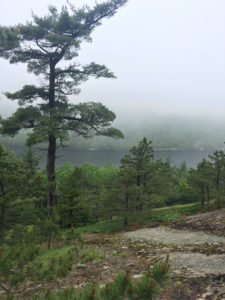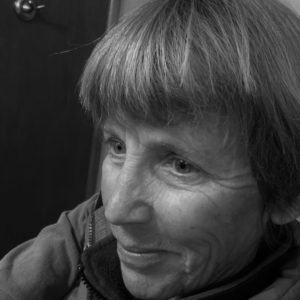 There was a forest between my grandmother’s house and the cliffs that rose from the sea. Spruce and balsam in equal share, white pine, red pine and a collection of towering hardwoods—single masts of maple and oak sailing along in an ocean of evergreens. For my purposes I needed the firs, the balsam. I’d take myself to the place where they were dominant and seat myself comfortably on the ground and strip their needles into a paper bag. When the bag was full and my thoughts settled, I’d walk back to the house.
There was a forest between my grandmother’s house and the cliffs that rose from the sea. Spruce and balsam in equal share, white pine, red pine and a collection of towering hardwoods—single masts of maple and oak sailing along in an ocean of evergreens. For my purposes I needed the firs, the balsam. I’d take myself to the place where they were dominant and seat myself comfortably on the ground and strip their needles into a paper bag. When the bag was full and my thoughts settled, I’d walk back to the house.
All summer on this island off the coast of Maine we saw the fog come and sometimes not go, and that was when we got to work making little pillows and filling them with sharp-scented balsam. I was clumsy with a needle and not much better at cutting out fabric, but my sister liked that part, so my job became collecting the balsam. I always went alone and sat where I could taste the sea and hear the lobster boats coming in and out of the harbor. I learned never to lean back against an evergreen or I’d come away sticky, and I learned that soft city hands can harden over a summer if they’re put to work stripping balsam. My thoughts were my own out there in the woods and the work had a purpose that pleased me. The whole world, as far as my senses could reach, smelled sweetly sharp and the wind foretold all kinds of weather as I sat and pretended this was my life’s labor and as much as I would ever need, ever.
When the island’s population grew and the cemetery grew with it, only one tree was left to stand in the new clearing, the tree that shaded my grandmother’s grave. It’s a maple tree, tall and straight and four arms around. My father is now buried in its shade, as is my mother and her sister and her sister’s husband. Every so often one of us cousins will suggest improvements to the plot: a gravel path between headstones or some new plantings that can survive the island’s wind and winters. I suppose we treat it like any other patch of real estate, minus the profit motive. It is, after all, a future home we share.
I’ve learned that people envy us our tree. It rustles in the summer’s good sailing winds and flames a flashy scarlet in the fall. In winter, when we aren’t there, it isn’t either—it’s gone deep inside itself to hibernate and restore. In spring, when we return, it leaps out again.
The Italian cousins are in the plot across the way. They don’t have our tree and their headstones are a little gaudy, made of pink granite. The daughter in the family bought a house at the foot of the newer part of the cemetery, the part that looks bare and joyless, like a suburb waiting for urban sprawl. She lives in a small brown house surrounded by a field of exotic cattle. The cattle don’t belong to her and she doesn’t mind them, though they come right up to her window and stick their wet noses against it. She washes the window every day because this is the window that gives her a view of her family.
My Uncle Gerrish is buried under a blanket of wild sod. Blueberries, cranberries, heather and sweet fern decorate his grave, though without constant watering the plot begins to wilt and takes on the appearance of brown shag carpeting. Those cousins don’t have our tree, either. What they say is, “Well, we have sod,” and we leave it at that.
Our tree is a Maine tree. Here in Arizona this spring I chose two flame maples, a serviceberry and two native chokecherries to plant around the yard. I told myself it was to make the house invisible in a neighborhood that’s growing taller, but really, I just miss trees. They’re practical and companionable and they soothe the eye. They’re generous with fruit and shade; they draw us in; they bring the birds. Calvert Vaux and Frederick Law Olmsted created a refuge for trees in Manhattan’s Central Park. It became a refuge for people, too. Like many New Yorkers, that’s where I met my first tree. It was a stunted little thing and it stood in a row of grander trees outside the playground fence. Its bark was smooth and red and when the crazy boy who slashed at trees slashed at that tree, I was astonished not to see it bleed.
We are learning about the underground networks that connect and protect communities of trees, a kind of cross-species call and response. If a birch needs something a fir has plenty of, the fir sends resources to the birch. This increases survival, and the age of these organisms is impossible to imagine. I’m certain some of the Old World trees have a cellular memory of the Trojan War; others shaded the lives of Hannibal and Jesus; yet others lost limbs to the fires that consumed Joan of Arc. And here in the New World, the bristlecones of the San Francisco Peaks, pinus aristata, diminutive and modest, were seedlings back when the decimal number system and its mind-altering concept of zero took hold.
The reason there’s so much talk about trees right now is because we’ve finally begun to realize the interconnectedness of all things, and the novelty of that just plain astonishes us. It challenges our thinking in the same way the limitless nature of the universe does. We talk and write about trees to try and come into alignment with this powerful truth. Trees are not individuals. Forests are entire communities above and below the soil. We can’t even see most of the interconnectedness we’re now asked to accept as we were once asked to accept the pear-shaped nature of the planet. When something as large as the earth shifts from flat to round, great disruptions occur. Nothing is unchanging, as much as we hope for it to be, and science is the right hand of change.
The human story is impossible to miss in the story of the trees. The truth that we are not separate is a blow to some, a relief to others. It was the great dilemma of Darwin’s time: How to quantify and communicate the equality of all life when everything in our human habit gave us dominion over the natural world and, as defined by race, each other. In delusion, we act that way still.

